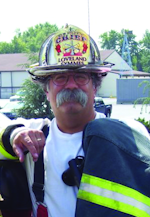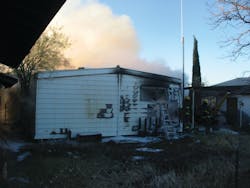Close Calls: Chief First on Scene: Working Fire, People Trapped - Part 2
Last month, we began reporting on an incident in which a fire chief arrived at a house fire with people trapped before the first apparatus could reach the scene. He had little choice but to force entry, search and make a rescue. For his heroic efforts, Chief Thomas O’Donohue of the Golden Valley, AZ, Fire District (GVFD) was the first fire chief to receive the International Association of Fire Chiefs/Motorola Solutions Benjamin Franklin Fire Service Award for Valor, the highest honor bestowed by the International Association of Fire Chiefs (IAFC).
Our sincere thanks to all of the members of the Golden Valley Fire District, Assistant Chief Ted Martin and Chief O’Donohue for their assistance with this column.
This incident timeline is provided by the GVFD:
7:38 A.M. –Chief 101 (Chief O’Donohue) responded to a reported residential structure fire at 5324 Destiny Way. Once enroute, O’Donohue reported a “large column of black smoke visible from approximately one mile away.”
7:39 – O’Donohue reported from the Alpha side of the structure, “On scene with a fully involved structure fire with exposures. Chief 101 will be Destiny Way Command.”
7:40 – O’Donohue reported over the radio, “Reports of person trapped in the home” per neighbors who stated the elderly woman resident was still inside the house. O’Donohue proceeded from the Alpha side to the Charlie side of the residence where screams for help could be heard. Once on the Charlie side (north) of the residence, O’Donohue witnessed two persons standing outside the structure: off-duty Golden Valley Firefighter/Engineer Steve Winn and neighbor Paul Bissonette. Both Bissonette and Winn were assisting neighbor Robert Davies, who was inside the structure holding the 92-year-old resident, Charlotte Sowards, next to a broken out bedroom window on the Bravo side of the Bravo/Charlie corner of the bedroom.
7:42 hours – Engine 111 (Captain B. Lewis) reported on scene and requested an assignment. O’Donohue advised over the radio, “Need an immediate crew to the Bravo/Charlie corner for an immediate rescue.” Smoke was billowing out of the bedroom. O’Donohue advised Davies that he (O’Donohue) would be assisting the two occupants out. C-101 attempted entry via a door on the Bravo side, but heavy fire conditions dictated that entry was untenable and would further compromise the rescue by opening the bedroom door, the only stopgap between the bedroom and the heavy fire.
O’Donohue returned to the Bravo-side window and advised Davies to cover their faces. O’Donohue broke out the second glass window to provide more fresh air to the occupants. He then proceeded to the Charlie side and entered the bedroom headfirst through the window, lowering himself to the floor to begin rescue operations. O’Donohue and Davies repeatedly attempted to lift the approximately 240-pound female occupant up and over the nearly five-foot-high windowsill on the Bravo side, noting the fire breaching the doorway and coming across the ceiling.
7:44 – O’Donohue requested personnel to the back of the structure for an “imminent rescue” and reported; “Chief 101 to responding units. I need people around the back of the structure for an imminent rescue, we’re inside.” O’Donohue and Davies now inched Sowards to the Charlie-side window due to fire beginning to breach the bedroom doorway and heavy fire developing outside the Bravo-side window.
7:45 – O’Donohue and Davies, now at the Charlie-side window, noted that the fire had completely breached the doorway and was spreading rapidly into the bedroom, up the walls and across the ceiling of the bedroom and coming over our heads. O’Donohue, with his right shoulder under the buttocks of Sowards and Davies lifting her left arm, pushed her out of the window into the arms of Winn, who slid her head first and prone down the six-foot stepladder outside the window. O’Donohue then assisted Davies up and out the window headfirst as well. O’Donohue then exited the structure out the same window.
Once outside, Winn, Davies and O’Donohue lifted the woman, who was lying on the ground, away from the window/wall area that was now well-engulfed in fire to reduce thermal/radiation burns to the two rescued persons. O’Donohue then reported over the radio, “We’ve rescued two people from inside the structure…send the ambulance around the back.”
The woman was transferred to the RMI ambulance crew for transport to the hospital. Davies was transferred to a second RMI ambulance for evaluation for smoke inhalation and cuts to his hands. O’Donohue self-transported to Kingman Regional Medical Center for evaluation for smoke inhalation.
Comments from Chief Goldfeder following discussion with Chief O’Donohue:
Congratulations to Chief O’Donohue for not only saving the victim’s life, but for reminding people that there are times when firefighters may have to take great risk to save someone who is savable.
In recent years, as firefighter survival has been brought to the forefront, there are plenty of people in all “corners” of the debate. Add the recent science applied to fire behavior (and its proven findings) and there is no shortage of opinions. Some want to always attack offensively. Some want to always operate defensively. The experienced ones understand it all depends on the conditions sized-up.
Then there are the extremes. For example, I recently saw a video of a firefighter who, in bunker gear, decided to “play” inside a well-involved building for absolutely no reason. He was demonstrating (for a local camera covering the fire at a single-family dwelling) his ability to walk inside the nearly collapsed burning house and show how he could “forcibly exit” the dwelling by forcing some door frames – the same door frames he had just walked through.
After his officer yelled at him, by name, to stay out, he walked to another area of the building, with the camera following him, and walked again inside what was left of this burning house and proceeded to force a door frame for no other reason than to play. No mask, no hoseline, no discipline, no respect – just a personal playground to play in. And that term was in the words of one of his own bosses who reached out in embarrassment. Firefighter bravery? No. Heroism? No. Risk? No. Science? No. Playtime. Cancerous smoke. Obvious collapse potential. No accountability. No discipline. No training.
It’s 2014 now and nearly 1,000 active firefighters are dealing with or are no longer dealing with cancer annually. Others die in collapses, and not because they were playing – because they were doing their jobs. They were disciplined, professional firefighters, be it career or volunteer, who did what was expected. And needed.
Some people contend that any firefighter line-of-duty death (LODD) is avoidable. Sure, if we don’t go to fires. Understand that there is a difference between necessary LODDs and unnecessary LODDs. If the above firefighter playing at that dwelling fire had tragically lost his life, it obviously would have been an unnecessary death. It was the epitome of freelancing. On the other hand, there are firefighters who did what had to be done, all doing their best, and lives were still lost. Hero firefighters died. This is a risky business, but in 2014, the training is there for us to make the best size-ups to minimize things from going wrong. Do the math yourself, to yourself, look at the reports and you decide personally what you would have done in the case of any LODD.
Recently, a veteran fire officer in Kentucky was at his brother-in-law’s house. They spotted a fire in a dwelling in their neighborhood. They reported it and ran to the smoking house, but had no personal protective equipment (PPE). Both were lieutenants in the local fire department. There were clear size-up indications and signs of life in that house, so they forced a door to search for a child known to be in the home. The house flashed over and the one lieutenant was trapped. The other fire officer made entry and heroically pulled the burning lieutenant out. Tragically, 50-plus days later, that lieutenant died from the injuries he sustained in that house. It turns out no one was in the home, but a car, a light and animals were clear signs that the family could have been in there. His size-up provided the information to indicate that there were “sized-up” reasons for him and his firefighter brother-in-law to take that risk.
So what would you do? You see a house on fire. You have obvious signs that the house is occupied. You are alone without full PPE or crew members. What would you do? Odds are, many of you would have done the same thing he did at that fire. I believe I would have. Maybe you would have; maybe you wouldn’t have. History shows that many firefighters in similar situations have absolutely saved lives by taking the risk based on the conditions and size-up. And experience. And training.
My point is that there is a full range of “what-if” situations and when we encounter “that” fire, it is reasonable to think that our training, experience and conditions help us “size it up” in determining what to do. There is no one way; it all depends.
In this close call, Chief Tom O’Donohue had moments to make a tough decision. When he pulled up, he pretty much figured it was a defensive fire. But when he did his 360-degree walk-around to fully size-up the situation, the scenario changed radically and he immediately knew what he had to do, based on his training, experience and the “now-found” conditions. Because of his actions, he made a huge and measurable difference in that moment of time by taking actions that mattered and two lives were saved.
Congratulations to Chief O’Donohue for taking that “sized-up” risk and rescuing those people. Once again, we learn the importance of size up and to conduct a 360 in any structure that is physically “360-able” to better understand what we are dealing with. The actions taken that day provide important information for firefighters to better understand that there are times when risks may have to be taken – and times where they do not have to be – and the range of possibilities in between.
WILLIAM GOLDFEDER, EFO, a Firehouse® contributing editor, has been a firefighter since 1973 and a chief officer since 1982. He is deputy fire chief of the Loveland-Symmes Fire Department in Ohio, an ISO Class 2 and CAAS-accredited department. Goldfeder has served on numerous National Fire Protection Association (NFPA) and International Association of Fire Chiefs (IAFC) committees. He is on the board of directors of the International Association of Fire Chiefs (representing the Safety, Health and Survival Section), National Fallen Firefighters Foundation, September 11th Families Association and National Firefighter Near-Miss Reporting System. Goldfeder and Gordon Graham host the free, non-commercial website www. firefighterclosecalls.com. Goldfeder can be contacted at [email protected]. Part one was in the October issue.

Billy Goldfeder
BILLY GOLDFEDER, EFO, who is a Firehouse contributing editor, has been a firefighter since 1973 and a chief officer since 1982. He is deputy fire chief of the Loveland-Symmes Fire Department in Ohio, which is an ISO Class 1, CPSE and CAAS-accredited department. Goldfeder has served on numerous NFPA and International Association of Fire Chiefs (IAFC) committees. He is on the board of directors of the IAFC Safety, Health and Survival Section and the National Fallen Firefighters Foundation.






